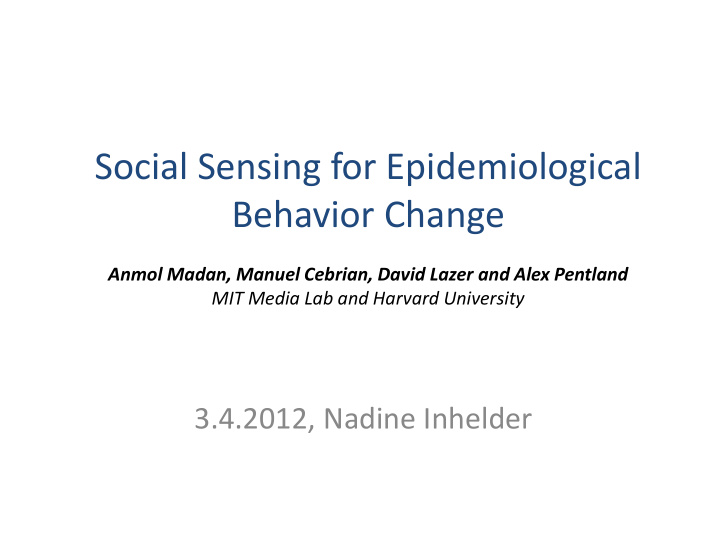



Social Sensing for Epidemiological Behavior Change Anmol Madan, Manuel Cebrian, David Lazer and Alex Pentland MIT Media Lab and Harvard University 3.4.2012, Nadine Inhelder
Paper Overview 2010 2011 Social Sensing for Epidemiological Behavior Change Using Social Sensing to Understand the Links Between Sleep, Mood, and Sociability Social Sensing: Obesity, Unhealthy Eating and Exercise in Face-to-Face Networks 2
Goal • Understand connection between behavior patterns and physical and mental health syndroms – Possibility for better epidemiological models – Basis for early-warning systems • Use mobile phone sensors to gather data • Detection and classification of health status without need to „ see “ the person 3
SIR Model • Transition from Susceptible to Infectious to Recovered • Expressed by a set of differential equations • Uses constant number of contacts to other people 4
Method • Study with 70 residents of an undergraduate hall – Collected data for 2 months • Social interaction data from mobile phones – Call data records – SMS logs – Bluetooth co-location sensing – WLAN-based location sensing • Use of a daily survey for symptom data – Questions designed by an epidemiologist – Smartphone unusable if survey not answered after 3 reminders – 63% completion rate 5
Privacy • Problem of Privacy when collecting a dataset like this – Approval by the Institutional Review Board (IRB) – Sensing scripts captures only hashed identifiers – Collected data is secured and anonymized before use 6
Results: Behavior Change Effects of Fever: 7
Results: Sympton Classification • Use of K-nearest-neighbor clustering to infer 4 classes of symptoms – stress + depression – runny nose + sore throat – fever + influenza – runny nose + sore throat + fever + influenza • Classification using a Bayesian-network classifier with MetaCost • Overall prediction accuracy of 60-80% 8
Results: Forecasting Highest ranked PSI (Phase Slope Index) relationships: 9
Ratings/Reviews • 10 Reviews with average of 1.7 • Limitations of Paper: – Assumption that the samples are independent – Does not consider behavior changes due to external events – Do people still answer the survey when ill or stressed? 10
Additional Paper 1 Social Sensing: Obesity, Unhealthy Eating and Exercise in Face-to-Face Networks (2010) • Goal: – Understanding the connection between social interactions and behavior considering eating and exercise • Method: – Same dataset used as for main paper – Regular surveys about weight, eating habits and exercise 11
Additional Paper 1 cont. • Results: – Most significant correlation of BMI increase and exposure to people with substantial weight gain – Exposure to overweight/obese people has influence on BMI – Exposure to unhealthy eating habits influences eating habits – No correlation with exposure to people with weight loss and healthy diet • Limitations: – Does not consider other factors like stress, illness, etc. – No interpretation of why these results occur 12
Additional Paper 2 Using Social Sensing to Understand the Links Between Sleep, Mood, and Sociability (2011) • Goals: – Learn more about the associations between sleep, mood and sociability – Improve public awareness of connections – Set a starting point for behavioral interventions that can improve public health through better social interaction • Method: – Study in young-family residential living community – Duration of 1 month, 54 participants – Social and behavioral software sensing platform „ Funf “ used – Regular surveys 13
Additional Paper 2 cont. • Results: 14
Additional Paper 2 cont. • Results: 15
Contribution • Use of off-the-shelf phones for social sensing • Convincing results on connections in different fields: – Epidemiology and behavior changes – Sleep, Mood and Sociability – Obesity, Unhealthy eating, Exercise and face-to-face networks • Starting point for new epidemiological models considering changes in behavior • Showing the possibility on inexpensive personal health monitoring 16
Future Work • Applications to predict illness based on gathered data • Give people advice for healthier lifestyle • Use of findings for a new epidemiologic model • Application for automatic information of doctors, etc. – Privacy issues? 17
Discussion • Does one model for epidemiological behavior change hold for all different cultures? • What future applications could you imagine using the proposed solutions? • What privacy implications does it have if such applications are widely used? • What‘s the impact of communication channels not covered by the study such as WhatsApp, Skype, etc.? 18
Recommend
More recommend